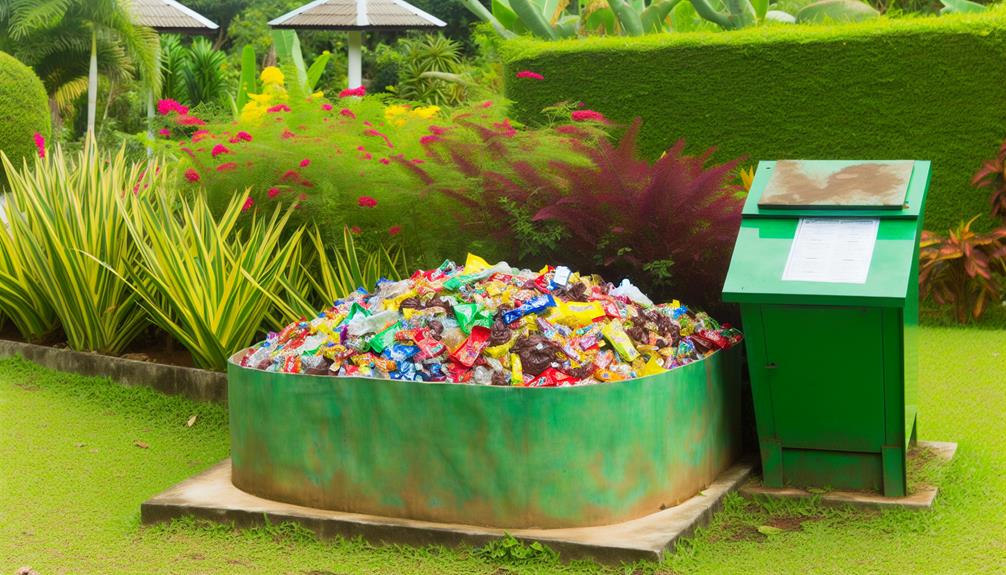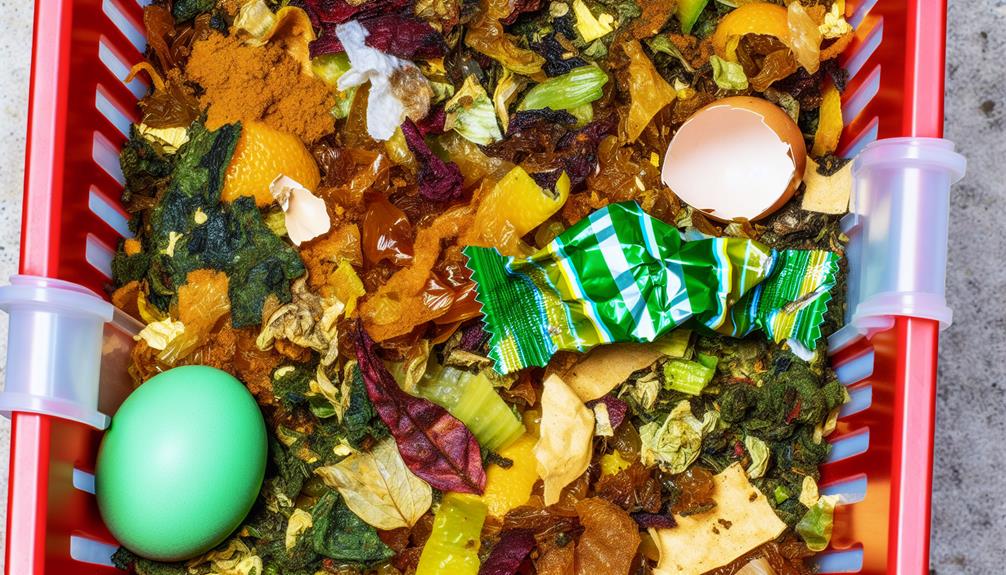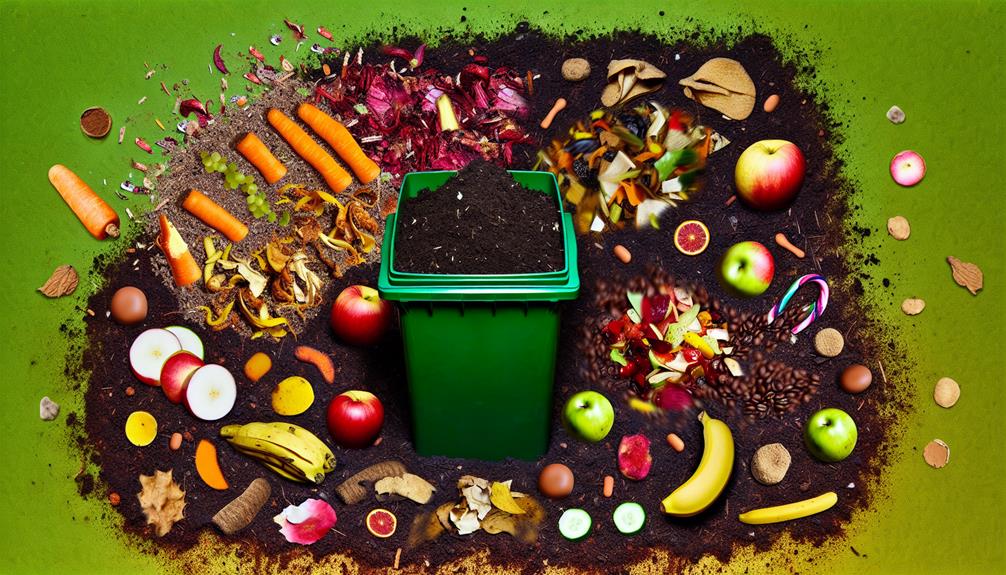

You shouldn’t compost candy wrappers because they’re non-biodegradable and can mess up your compost’s balance. These wrappers are usually made from a mix of plastic, aluminum, and paper, which takes 10-20 years to decompose and lacks essential nutrients.
This can harm your compost’s quality and disrupt the crucial carbon to nitrogen ratio needed for effective composting. Instead, explore local recycling programs to see if they accept candy wrappers. To maintain a sustainable lifestyle, choose biodegradable packaging when possible. Get ready to explore more tips on making your compost healthy and vibrant!
Candy wrappers usually consist of materials like plastic, aluminum, and paper, making them tough to compost. You’ll find that these components don’t break down easily and can disrupt the composting process. However, exploring biodegradable options could offer a more eco-friendly solution and enhance your composting success.
You’ll often find that candy wrappers are made from a mix of materials, such as plastic combined with aluminum foil or paper layered with aluminum foil. This combination makes these wrappers challenging to recycle because the materials need to be separated for efficient processing.
When you’re trying to compost, these mixed-material wrappers can cause issues. They don’t break down properly and can disrupt the balance of green and brown materials, which is essential for successful composting.
| Material | Composition Type |
|---|---|
| Plastic + Aluminum Foil | Hard to separate, not compostable |
| Paper + Aluminum Foil | Hard to separate, not compostable |
| Single Material | Easier to recycle, sometimes compostable |
Understanding the composition helps you make informed decisions about waste management.
When considering biodegradable options, you should look for wrappers made from materials like plant-based plastics or paper that can break down easily in compost. These biodegradable materials are kinder to the environment and decompose much faster than traditional candy wrappers.
Unlike the usual mix of plastic and aluminum foil, these eco-friendly alternatives won’t disrupt the essential balance of your compost pile. By choosing products with biodegradable wrappers, you’re helping to create a healthier ecosystem, as these materials contribute beneficial nutrients to your compost.
Embracing biodegradable options not only supports a sustainable lifestyle but also fosters a sense of community among like-minded individuals who care about the planet. So, make the switch and inspire others to do the same!
Also Read: Can You Compost Ash From Wood?
Understanding the decomposition timeframe of candy wrappers is essential for effective composting practices. Unlike compostable materials, candy wrappers can take 10-20 years to break down. This extended period disrupts the balance of brown and green composting materials, important for a thriving compost environment.

Candy wrappers have a carbon to nitrogen ratio of 0, making them unsuitable for compost heaps. Including them hinders the quality and effectiveness of your finished compost. To maintain an ideal green-brown mix, it’s best to keep non-compostable items like candy wrappers out.
Frequently, including candy wrappers in your compost can severely degrade the quality of the finished product. These non-biodegradable materials take 10-20 years to decompose, disrupting the compostable process. Microorganisms struggle with the complex mix of plastic and aluminum foil, which offers no beneficial nutrients.
This slow decomposition impedes the efficiency of your composting environment, leaving you with a product that’s less nutrient-rich and more contaminated.
Candy wrappers simply don’t belong in a compost bin if you’re aiming for high-quality compost. Instead, focus on adding truly compostable items that break down quickly and contribute positively to the overall health of your compost. By doing so, you’ll guarantee a thriving, nutrient-rich compost pile that benefits your garden and the environment.
Understanding the carbon to nitrogen ratio is essential for maintaining an ideal composting balance. Candy wrappers can throw a wrench in the works because they lack nitrogen. This disruption hinders the decomposition process, making it harder for your compost pile to break down organic materials effectively.
To manage the decomposition rate, you’ll need to supplement with nitrogen-rich greens to counteract the imbalance created by adding candy wrappers.
Achieving the ideal carbon to nitrogen ratio is essential for efficient composting. The composting process thrives on a balanced mix of carbon-rich ‘browns’ and nitrogen-rich ‘greens.’
Without this balance, your compost pile can become a smelly, inefficient mess. Candy wrappers, unfortunately, have a carbon to nitrogen ratio of zero, offering nothing beneficial to the composting process. Their lack of nitrogen and non-biodegradable nature means they hinder decomposition, slowing down the breakdown of other organic materials.
To maintain a healthy and efficient composting ecosystem, you should avoid adding candy wrappers. Focus instead on balancing your compost with proper brown and green materials, ensuring a thriving, nutrient-rich compost pile that benefits your garden and the environment.
You need to focus on organic material sources that maintain the right carbon to nitrogen ratio for successful composting. A balanced compost pile is essential for healthy decomposition and nutrient-rich compost.
Aim for a mix of brown and green materials:
Avoid candy wrappers: they lack nitrogen and disrupt balance.
Monitor ratios: a 30:1 carbon to nitrogen ratio is ideal.
Adjust as needed: if your pile smells, add more brown materials.
Maintaining the carbon to nitrogen ratio is crucial for accelerating the decomposition rate in your compost pile. Candy wrappers, with a carbon to nitrogen ratio of 0, disrupt this balance, stalling the breakdown process. The ideal mix of green and brown materials fosters a thriving environment for microorganisms, which candy wrappers hinder.
You want to guarantee that your compost pile decomposes efficiently, providing nutrient-rich soil, but candy wrappers offer no beneficial nutrients and can take 10-20 years to break down.
Here’s a quick guide to composting materials:
| Material | Carbon to Nitrogen Ratio |
|---|---|
| Candy Wrappers | 0 |
| Green Materials | 1:1 to 30:1 |
| Brown Materials | 30:1 to 80:1 |
Also Read: Can You Compost Arugula?
When looking for alternative disposal methods for candy wrappers, consider exploring local recycling programs that accept mixed-material packaging. Reducing your environmental impact is important, and there are several ways you can make a difference:
Explore your local recycling programs to discover the best ways to dispose of candy wrappers responsibly. Reach out to your city or waste management department for guidelines on recycling candy wrappers.
Some areas might offer specialized recycling options for mixed-material packaging, which includes many types of candy wrappers. It’s crucial to learn if your local facilities accept recyclable wrappers to guarantee you’re disposing of them correctly.
Reducing non-biodegradable waste starts with being conscious of the products you buy and use daily. Candy wrappers, for example, are non-biodegradable due to their mix of plastic and aluminum foil, making them a poor choice for composting.
Instead, focus on reducing waste by:
Also Read: Can You Compost Alcohol?
Healthy composting starts with maintaining a balanced mix of carbon-rich browns and nitrogen-rich greens. You’ll need items like leaves and cardboard for browns, and food scraps or lawn clippings for greens.

Monitoring the temperature with a compost thermometer guarantees everything breaks down efficiently. Don’t add candy wrappers to your compost; they’re made of materials that disrupt the necessary balance. Instead, find local recycling programs to properly dispose of candy wrappers and reduce environmental impact.
Regularly aerate your compost and control moisture levels to keep the process active and healthy. By following these tips, you’ll create nutrient-rich compost that enhances your garden, fostering a sense of community and connection with nature.
To properly dispose of candy wrappers, don’t add them to compost. Instead, check local recycling programs that accept them. This way, you’re helping the environment and contributing to a community of eco-conscious individuals.
You can’t put candy in the compost because its high sugar content attracts pests and disrupts decomposing processes. Instead, add fruits, veggies, and yard waste to your compost. Let’s keep our compost piles healthy together!
Food wrappers aren’t compostable because they’re made of mixed materials like plastic and aluminum. You’ll disrupt the composting process and harm the environment. Stick to composting organic waste to keep your compost healthy and sustainable.
Yes, candy wrappers are a type of waste. They aren’t biodegradable, making them tough to decompose. Composting them disrupts the balance and offers no nutrients. Let’s keep our compost healthy and avoid adding wrappers.
So, can you compost candy wrappers? The answer is mostly no, due to their mixed materials and slow decomposition.
Instead, focus on recycling programs and reducing non-biodegradable waste.
By understanding the composition of candy wrappers, you can make informed choices that benefit your compost and the environment.
Remember, healthy composting involves balancing your carbon to nitrogen ratio, so stick to organic materials.
Let’s aim for a greener planet, one step at a time!
